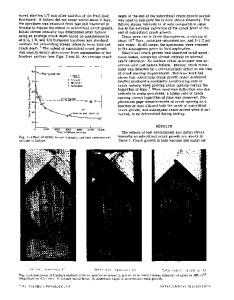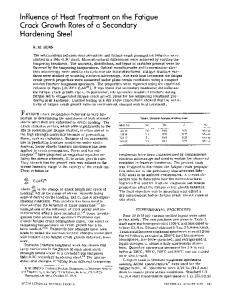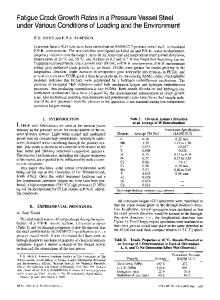The effect of environment on the sustained load crack growth rates of forged WASPALOY
- PDF / 695,102 Bytes
- 6 Pages / 612 x 792 pts (letter) Page_size
- 59 Downloads / 296 Views
I.
INTRODUCTION
D U R I N G the past two decades drastic changes have occurred in the design criteria and material property requirements for critical structural components of gas turbine engines. In order to provide a safe component operating life, the conventional approach has been to take a lower bound of the mean low cycle fatigue life that is equivalent to a probability of 1/1000 of initiating a detectable crack during the design lifetime of the component. In practice, all components are removed from service after reaching the design lifetime, and this translates into 999 out of 1000 components which are still structurally sound being retired from service. In an attempt to utilize the remaining life of these 999 components, without sacrificing structural safety, a revised design philosophy is being implemented with some components in advanced engines. Under this new design approach, which has been referred to as Retirement for Cause, components are to undergo periodic inspection and are returned to service if no cracks larger than a specified size are detected. In order to apply this methodology, an accurate prediction of crack growth rates under conditions representing the service conditions is required. The loading spectrum imposed on rotating component, e.g., turbine disks, includes a mix of fatigue and sustained load cycles. Crack growth models are required which are able to describe accurately the cyclic and the sustained-load crack growth behavior of the material, as well as to account for the interactions between sustained and cyclic loads. While research addressing the problem of crack growth under combined thermal and mechanical cycling is in progress, considerable knowledge has been obtained from studies of crack growth under isothermal cycling and sustained load conditions. Sustained load crack growth rates under isothermal conditions have been measured for several nickel-base alloys. ~ The term "creep crack growth" is used to describe the propagation of a single macroscopic crack under sustained load at temperatures well within the creep regime (T/Tm >-- 0.4).
Yet, the contribution of creep, as a driving force for crack propagation, varies significantly for different alloy systems. More specifically, in advanced creep resistant alloys, such as nickel-base superalloys, the contribution of pure creep micromechanisms to sustained load crack growth is very small. This observation eventually makes the use of the term "creep crack growth" inappropiate. A better designation of the phenomena would be "high temperature, environment assisted crack growth". The experimental data are usually reported as a crack advance per unit time (da/dt) vs the mode I elastic stress intensity factor Kx. The stress intensity factor Kx has been found to provide a good correlation between load and geometry factors and the sustained load crack growth data. 5 This correlation can be rationalized on the basis of the principles of fracture mechanics of creeping solids derived by Riedel and Rice. 6 Similar observations showing tha
Data Loading...











